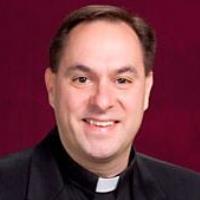We’ve all heard them: preachers that add a “w” to the word “God.” “Gaaaa-wd calls us to luuuu-uuve our neighbor,” turning one-syllable words into multisyllabic forms. (Think Reverend Lovejoy from “The Simpsons.”)
Perhaps you’ve listened to a sermon by a preacher whose public “preacher voice” sounds affected, different, not like regular conversation.
This kind of vocal affectation can seem odd and out of character to listeners. To me, it doesn’t seem to be the right form for a sermon, where I expect to hear the gospel in the preacher’s own voice. When the preacher’s voice is “off,” I’m distracted to the point that it’s hard to remember the content of the sermon.
Recently, I was asked to consider the difference between writing for a sermon and writing for the liturgy. Affected speech is not the (only) difference!
My experience, however, makes me think that our assumptions about public speech are different in preaching and in praying. While it’s not in how we pronounce words, there is an assumption that prayer language is deeper and richer than our conversational language.
The sermon is personal, even though preachers speak the gospel on behalf of the gathered assembly. We assume that the preacher is speaking the gospel through their own experience. In fact, we expect that. It’s often narrative and entertaining in a way that connects with us. We’re more audience in sermon than in other parts of the worship service, even in places where there is a rich sense of call and response. We look for the preacher’s expertise in providing commentary on a text: exegetical, theological, social, political. Clearly, the directionality of the speech is from one to many.
When we do liturgy together, there is a different set of assumptions. The language is shared. Prayer is something that we do together. The leader is understood to be speaking for and with us, rather than to us. The directionality is different; more us to God; God to us. There’s also a difference in style of speech. Liturgical language has cadence. Not necessarily poetic — although sometimes it is — liturgy carries meaning and emotion like music. Words are often layered, multivalent, saturated in history and shared experience. Liturgy lets symbolic words stand on their own, rather than provide commentary on their meaning.
If preaching is conversational, liturgy is metaphorical, although it’s certainly possible for preaching to be metaphorical and liturgy to be conversational. Liturgy is steeped in biblical metaphor, yet should, at the same time, be creative and new. When writing prayer language, there should be attention to context. How is a word or phrase understood in this place? What other concepts associate with this idea or metaphor? Where will it take our minds if we hear it? Prayer language, if used over time, becomes formative in a way that sermons do not. Because we repeat over and over words or phrases, they come to guide our thinking or feeling. Sermons, of course, are seldom heard or read again (at least for us regular preachers!).1
One final thought that applies both to writing sermons and writing liturgy. The mental constructs we use have an impact.
For example, our assumptions about how the world or the cosmos are structured will shape our language choices. Increasingly, we are being invited to think in non-binary ways. The Western model of either/or is proving insufficient in properly describing authentic human experience. We’re living in creative time as we are invited to think of our speech as non-sexist, non-hierarchical, non-phobic, non-gendered.
In my congregation, we’ve been challenged by some members to think of new ways to say “brothers and sisters” so that we can embrace those who may be in a different place on the gender spectrum. We’ve been working to think of relational, communal words that aren’t so gendered. We’ve come up with “beloved,” “friends,” “siblings,” “family.” Yet even “brothers and sisters,” once the wider, more inclusive phrase, is now being examined. This is the wonderful challenge of human language.
How, indeed, do we speak of the unspeakable in limited human language? In the end, I suppose it’s the work of incarnation.
How do you consider the difference in writing sermons or writing liturgy? Are there considerations that we should think about? Just promise me that you’ll eliminate all “w’s” from God.
Notes
1 In These Or Similar Words: Crafting Language for Worship (Minneapolis: Augsburg Fortress, 2015), 14-19.

